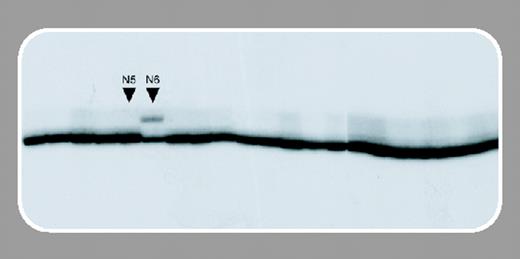Chromosome 21 is the smallest human chromosome containing an estimated 329 genes, yet numeric and structural abnormalities of chromosome 21 are 2 of the most frequent chromosomal abnormalities in childhood leukemias. The unique association of Down syndrome (DS) and acute megakaryoblastic leukemia (AMKL), which has been estimated to develop in up to 2% of DS children,1 and the variant in DS newborns known as the transient myeloproliferative disorder (TMD) highlight the increased predisposition of DS children to develop acute myeloid leukemia (AML) and acute lymphoblastic leukemia (ALL). Recently, considerable interest has been generated following reports of acquired somatic mutations in exon 2 of the erythroid/megakaryocyte transcription factor gene, GATA1, exclusively in all DS AMKL and TMD cases.2,3
Newborn screening (Guthrie) cards used to identify a variety of genetic diseases at birth are an invaluable repository of archival blood specimens to identify the presence of diseases in newborns and have been used to demonstrate the prenatal origin of childhood ALL cases.4 While Tarot cards may not be able to predict the future, Guthrie cards could potentially be used to identify DS newborns who are at risk for developing AMKL. Ahmed and colleagues (page 2480) continue to increase our rapidly expanding knowledge of leukemogenesis in DS by screening for GATA1 mutations using Guthrie cards and umbilical cord samples of DS newborns. Using a radioactivity-based assay with improved sensitivity to detect mutations, GATA1 mutations were detected in 16 DS TMD and AMKL cases, 3 of 4 Guthrie cards of DS AMKL patients, and 2 of 21 DS umbilical cord samples; the latter 2 groups did not have a clinical history of TMD, suggesting a prenatal origin of GATA1 mutations (which is known to occur in TMD cases) in AMKL cases. There were 4 AMKL patients who demonstrated multiple GATA1 mutations, a finding that has not been reported previously.
Identifying new clues in the biology of leukemia in DS children leads to several unanswered questions. What is the linkage of constitutional trisomy 21 and the generation of GATA1 mutations, whose gene resides on chromosome X, and does this suggest that other unidentified leukemia-associated genes harbor mutations in DS blast cells? Is the presence of GATA1 mutations sufficient for a diagnosis of TMD in DS newborns or can mutations be detected in healthy DS newborns who have been thoroughly evaluated to exclude evidence of TMD? These questions will likely be addressed in the future with large prospective population-based studies screening all DS newborns for GATA1 mutations and examining peripheral blood samples morphologically and by flow cytometry for the presence of megakaryoblasts. If it is clearly demonstrated that GATA1 mutations can exist in DS newborns without evidence of TMD (who are at risk for the development of AMKL), an intriguing concept could involve early interventions (eg, low-dose cytosine arabinoside [ara-C] therapy) to eliminate the clones containing the mutation and potentially prevent the subsequent development of AMKL.
Compared with AML and the identification of GATA1 mutations, no common biologic characteristics have linked DS ALL cases together. Ahmed et al's study suggests that the examination of Guthrie cards to determine whether DS ALL cases have a prenatal origin is a logical starting point.


This feature is available to Subscribers Only
Sign In or Create an Account Close Modal